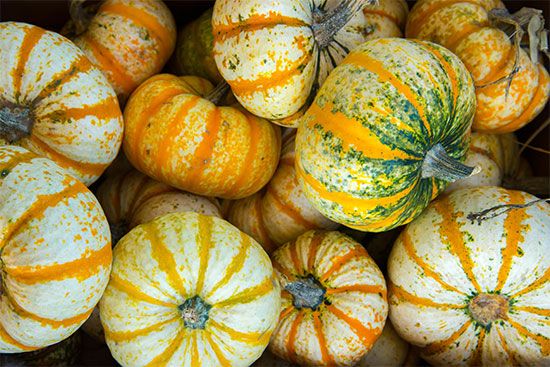Cucurbitales
- Related Topics:
- Cucurbitaceae
- Begoniaceae
- Datiscaceae
- Corynocarpaceae
- Coriariceae
Cucurbitales, small order of flowering plants containing seven families, 129 genera, and 2,295 species. It includes Begoniaceae, the begonia family, with 60 percent of the species in the order, and Cucurbitaceae, the squash, gourd, and cucumber family, with 90 percent of the genera in the order. In addition, Cucurbitales includes five small families: Anisophylleaceae, Coriariaceae, Corynocarpaceae, Datiscaceae, and Tetramelaceae.
Cucurbitales is a Rosid I order and is close to Fagales. Species in the order tend to have the veins in the leaf radiating from the base; the sepals and petals often are not sharply different; and the styles are free. Many species have inferior ovaries, and male and female flowers are often distinct, although usually borne on the same plant.
Cucurbitales is a curious assemblage of families. Cucurbitaceae, Datiscaceae, and Begoniaceae traditionally have been placed together, often with other families that have ovules on the walls of the ovary, such as Violaceae, or the violet family. Corynocarpaceae has long been a family of uncertain position. Before DNA studies, Coriariaceae was linked with Ranunculaceae because of its separate carpels. Anisophylleaceae was formerly linked to or included in Rhizophoraceae, a family that now belongs to the order Malpighiales but in the past was often linked to the order Myrtales. Flowers of some Anisophylleaceae are remarkably like those of some Cunoniaceae (order Oxalidales), down to the fine details observable during development, but this seems to be because of a mixture of persistence of a common ground plan and evolutionary convergence. For more information on the modern Angiosperm Phylogeny Group II (APG II) botanical classification system, see angiosperm.
Begoniaceae
Members of Begoniaceae are succulent herbs or sometimes climbers; there are 2 genera and more than 1,400 species, and they occur throughout the tropics and into subtropical regions. Begonia includes all the species in the family minus one; it occurs throughout the family’s range but is not native to Hawaii. The excluded species is Hillebrandia sandwicensis, which is restricted to Hawaii. The family often has leaves in two ranks; the base of the blades is asymmetrical, and there are well-developed teeth and stipules. The plants have both male and female flowers in the same flowering unit (inflorescence). Begonia has petals and sepals that are petal-like, a form known as tepals. The ovules are borne in the centre of an inferior ovary, and the stigmas are large, divided, and often twisted. The fruit is a capsule, often with asymmetrical wings, or rarely a berry.
Male and female flowers of Begonia may have different numbers of tepals; male flowers open first at the base of the inflorescence, with female flowers appearing later. Both stigmas and anthers are often bright yellow. The flowers usually contain no nectar, though bees and other pollinators may visit the female flower expecting to find pollen—a kind of “deceit pollination.” The seeds of Begoniaceae have a small lid surrounded by specialized cells. Begonia rex can produce plantlets directly from the leaf, which is very unusual in flowering plants. How Hillebrandia came to be restricted to Hawaii is unknown; the genus appears to have originated well before Begonia, more than 50 million years ago, but the Hawaiian Islands are volcanic and of much younger age. Hillebrandia has a number of “primitive” features, including the presence of five sepals and five small petals in female flowers and an only partly inferior ovary.

The leaves of some African and Asian Begonia species are edible; in South America some species are eaten to prevent scurvy. Rhizomes of certain species in South America are used for their medicinal qualities as astringents, as treatment for fever, as antisyphilitics, and as laxatives.
Begonia is of considerable horticultural interest, with many species and hybrids prized as house or garden plants. Classifications of begonias for horticultural purposes are quite different from those for botanical studies, with species valued for their potential in producing hybrids rather than their botanical relationships. Variations in growth habit, leaves (including colour patterns), inflorescence type, flower size and colour, and length of blooming period are all of horticultural value.
Three groups of species are of particular interest to horticulturists. One is cultivated for its leaves, including especially B. rex. Another, valued for its flowers, is subdivided into a group of small-flowered plants centred on B. cucullata (more commonly called B. semperflorens) and a group of large-flowered plants, including the tuberous begonias, such as B. rosaeflora, B. veitchii, B. boliviensis, and B. x tuberhybrida. A third group has both ornamental flowers and decorative leaves and includes B. scharffiana and B. metallica, from which came the hybrid B. x credneri. Modern growers place begonias in four groups: (1) fibrous-rooted, including the wax (B. semperflorens), the cane-stemmed, and the hirsute, or hairy, (2) the rhizomatous, (3) the rex-cultorum, or rex, and (4) the tuberous-rooted.



















